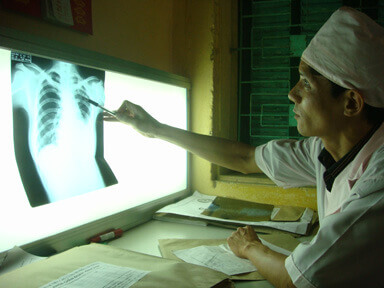In this guest post, Eleonora Jiménez-Levi—senior researcher at the Treatment Action Group (TAG)—writes about the latest report on the state of funding for tuberculosis (TB) research and product development.
Mycobacterium tuberculosis (MTB) is one of the oldest known human pathogens that continues to pose a global public health threat in the 21st
century. The World Health Organization reports that MTB—the bacterium that causes TB disease—was responsible for 1.4 million deaths
in 2011, including 430,000 deaths among people with HIV.
Current strategies and tools cannot effectively prevent and control TB. BCG, the only vaccine approved for TB, is over 100 years old. BCG cannot offer
protection against pulmonary TB, and cannot be used among HIV-positive infants. The most widely used diagnostic tool—sputum smear microscopy—detects
roughly 50 percent of pulmonary TB cases, and fares far worse among people with immature or compromised immune systems. Treatment against drug-sensitive
TB involves 6–9 months of first-line drugs, and drug-resistant TB requires 20 months or more. The lengthy treatment regimen results in suboptimal
and, at times, deadly outcomes because of several challenges including difficulty of adhering to treatment, drug stock-outs, toxic side effects,
treatment costs, and incompatibility between TB drugs and antiretroviral medicines for people with HIV.

- A doctor examines the chest x-ray of a TB patient. Photo credit: PATH.
For the seventh year, TAG and the Stop TB Partnership have published the latest investment data and analysis on the state of global TB research and
development (R&D) funding. The 2012 Report on Tuberculosis Research Funding Trends: 2005–2011 builds on seven years of investment data to report on annual funding trends and gaps among the leading TB R&D donors. The report analyzes current
spending levels across six research areas to assess how they compare to the R&D funding targets in the Global Plan to Stop TB 2011-2015.
The new report found that in 2011, 81 donors invested $649.6 million in TB R&D. This is an 82 percent increase from the baseline year of 2005,
but only a 3 percent increase over 2010 funding. The top ten donors disbursed $506.7 million of the $649.6 million total, or 78 percent of the
global share. Despite the small funding increase observed between 2010 and 2011, the world continues to fall $1.35 billion short of the annual
$2 billion funding target recommended by the Global Plan.
To accelerate global TB R&D and capitalize on the scientific gains achieved in the last decade for drug, vaccine, and diagnostic development, more
financial resources are needed, particularly in:
- Biomarker discovery to modernize TB drug and vaccine development by demonstrating the progress and effects of treatment or immunity early on, which
in turn radically reduces the time and costs of the clinical trials.
- Biomarker discovery for the development of a point-of-care diagnostic test that can identify people with latent TB at risk of developing active
TB, as well as biomarkers associated with infection, treatment response, cure, and drug susceptibility or resistance.
- TB sample banks that support biomarker discovery with well-characterized specimens.
- Late-stage drug and vaccine clinical trials, many of which will take place in high-burden countries with limited laboratory capacity or infrastructure
that meet good clinical practice standards.
- Basic science research to enhance our scientific understanding of TB disease and the MTB pathogen.
The global TB community should also give further consideration to:
- Establishing access plans to optimize the rational use of new TB drugs and regimens when they become available, as well as prevent the emergence
of resistance to new TB treatments.
- Developing pediatric investigational plans to ensure child-friendly formulations are available as quickly as possible.
- Conducting drug-drug interaction studies for novel TB drug regimens.
- Providing compassionate use and expanded access, which are particularly important for people with drug-resistant TB who have limited treatment
options.
- Modernizing TB regulatory guidelines and streamlining regulatory requirements across and within regions.
All of these recommendations and more can be accomplished if policymakers, researchers, activists, clinicians, donors, implementers, and people affected
by TB pledge their commitment to achieve zero TB deaths, zero new TB infections, and zero suffering from TB. The Zero Declaration,
created by a worldwide group of TB stakeholders in June 2012, is a new strategy that calls on the international community to embrace a “new global
attitude in the fight against TB … and mobilize sufficient political will and resources to prevent needless transmission, sickness, and
death.” The goal of the campaign is to organize and inspire people to work toward eliminating TB as a public health threat with greater urgency,
more political will, and increased investments.
Promising new tools are on the horizon, but without political will and adequate funding to support the development of new vaccines, diagnostics, and
drugs, the world will not be able to contain the growing problem that drug-resistant TB poses, much less eliminate TB as a public health threat
by 2050.

